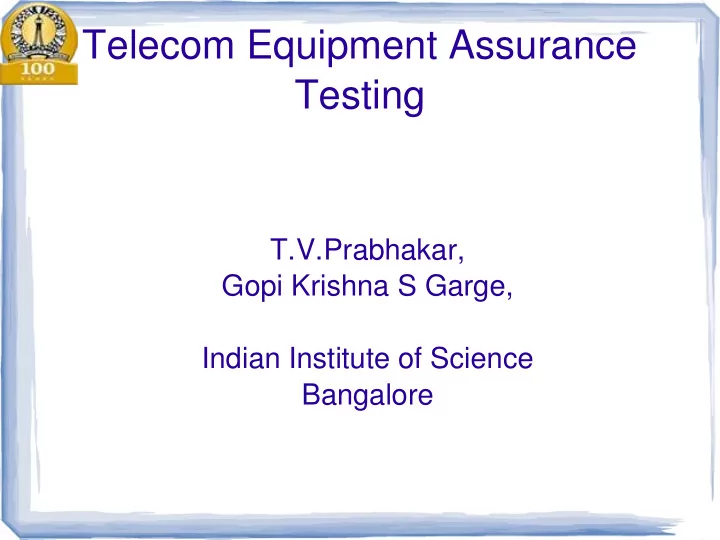

Telecom Equipment Assurance Testing T.V.Prabhakar, Gopi Krishna S Garge, Indian Institute of Science Bangalore
Agenda Overview of the TETC Security Testing & requirements Security Standards? Is there a formalism to what we want? Can TTCN 3 help? Discussion
Our Mission Telecom space − Telecom includes data networking; focus on DN − Equipment acceptance tests − Security Evaluation − Safe-to-connect certification − Publish guidelines for procurers and OEMs
Objectives Set up an assurance test facility Tests include − Telecom Equipment (untrusted) − Detect hidden malicious code/systems within − Other h/w and s/w weaknesses that may exist Set up contractual terms for suppliers Review the requirements of such assurance facilities
Assurance Testing Product and System assurance Suite of tests − Vulnerability Analysis − Penetration Testing (BB and fuzzing) − Deep Inspection (source code, processes, etc.) − Non-functional tests, SVCT, MVCT, etc.
Assurance Framework Common criteria (adapted?) − Criteria, methodology and recognition for IT security evaluation − Protection Profiles − Security Targets − Testing and Evaluation Can we use TTCN 3 in such a context?
Security Evaluation Risk estimation and Deployment Targets What to protect? What protection to evaluate? Formal Representation? Grammar? Translate to a spec language? Derive test suites? − Code for execution − Code inclusion − Verdict/security level quantification
Security Tests Compliant vs Vulnerable Test Design − SUT Load Conditions Responses Graceful degradation/recovery − Attack Parameters Persistent vs non-persistent low/med/high persistence Single vs multiple attacks Detection avoidance
TTCN-3 Applications • Mobile communications – LTE, WiMAX, 3G, TETRA, GSM • Broadband technologies – ATM, DSL • Middleware platforms – WebServices, CORBA, CCM, EJB • Internet protocols – SIP, IMS, IPv6 and SIGTRAN • Smart Cards • Automotive – AUTOSAR, MOST, CAN
Security Standards • ETSI and the eEurope programme – 2005 • STF 356 – Making better security standards th ETSI Security Workshop • 4 – EG 202 387, Common Criteria – ES 202 382, Protection Profile – ES 202 383, Security Target
Security Standards • Any requirement should be testable • Any security requirement must be testable AND must achieve its security objective • Open development of crypto has been the norm for a number of years (AES for example) • Security systems need to be open to examination • Assurance evaluation schemes fit the model • Designing in anticipation of assurance evaluation is good practice
Security Standards • Risk analysis is still top of the process tree • Objectives still have to be established before requirements • Crypto based solutions by themselves don’t provide security
Security Testing • Telecom equipment security testing means: – Equipment is free from vulnerabilities • DOS, Buffer overflow, Remote Code Execution, Format string, Malloc bombs, .. – Equipment is free from virus and malware – Equipment is recommended for “safe to connect”
Security testing approaches • Several approaches are possible: – Attack the equipment and observe its capability to withstand or mitigate the attack • Attack heuristics can be developed – Perform a black box robustness testing and look for implementation level security • Design test cases – Complete coverage of the input space – Monitor traffic with a sniffer and analyze the data with appropriate filters – Monitor a deviation from the baseline – anomaly detection?
Security testing • TTCN-3 based security test suites, when done, have to be made publicly available • Threat and Risk perceptions master script – Recommends the actual scripts that are required to be run • Certification scripts adhering to security standards are urgently required – Common Criteria based Protection profiles will be invaluable • Client-Server/ Peer scripts to maintain security assurance of production equipment – Eg: Impact of opening a firewall’s port on core router
Using TTCN 3 Grammar for expressing network policy violations Representation of exploits as action sequence trees Compliance vs Vulnerability Stateful protocols Synchronization
The formalism available: An Illustration
Terminology
Characteristic
Symptoms
Symptom Definitions
Vulnerability
Exploit
Algorithm
ntp Vulnerability
VLAN Vulnerability
So, Is this formalism helpful? • What is required in terms of functions and • libraries? Use the IPv6 core and common libraries to • generate prototype test suites? Follow up with a similar approach for layer 4 • protocols? Is this feasible? Known effort - TTCN 3 and Security – T3FAH •
Thank You
Recommend
More recommend